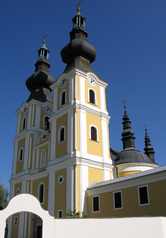- Máriapócs
-
Máriapócs Country  Hungary
HungaryCounty Szabolcs-Szatmár-Bereg Area - Total 22.09 km2 (8.5 sq mi) Population (2001) - Total 2,186 - Density 99/km2 (256.4/sq mi) Time zone CET (UTC+1) - Summer (DST) CEST (UTC+2) Postal code 4326 Area code(s) 42 Máriapócs (Romanian: Pociu) is a small town in Szabolcs-Szatmár-Bereg county, in the Northern Great Plain region of eastern Hungary. It lies near Nyíregyháza. It is an important place for pilgrimage. It has a gorgeous Greek Catholic church, which houses the Weeping Black Madonna, an enormous and unbelievably ornate iconostasis that now takes pride of place above the altar. This icon is not the original, but a 19th century copy. The original one is kept in St. Stephen's Cathedral in Vienna.
MÁRIAPÓCS-HUNGARIAN GREEK CATHOLIC SHRINE OF WEEPING MOTHER OF GOD
Among Carpatho-Rusyn Christians, the Weeping Icon of Marijapovch is revered because it stands for believers as a witness to the protection and intercession of the Most Holy Mother of God. The icon itself comes from and expresses the life of the Church in Eastern Europe. Its rich history reflects a deeply rooted faith in God and a trusting devotion to the Mother of God. In the northeastern plains of Hungary, in the village of Povch (former Szabolcs County), stands the Monastery of the Basilian Fathers, with a magnificent church. Stefan Papp, brother of the pastor of the church in Povch, who had studied art in Italy, was engaged by Laszlo Csigri to write an icon of the Mother of God for the ikonostas. He painted the Virgin Mother on wood holding the Divine Infant with a three-petaled tulip in His hand. Unable to pay for the icon, Lorincz Hurta, a well-to-do parishioner, donated it to the church. In this church the first weeping of the icon of the Mother of God took place on November 14, 1696 according to the Julian calendar. The same miracle occurred again from December 8 to 19th of the same year. Needless to say, this miracle was a great consolation to the discouraged people of Povch. Ever since the first miraculous weeping, the village of Povch has been called Marijapovch (in Hungarian, Mariapocs). When Leopold I, Emperor of Austria, had been informed of the miraculous icon, he immediately had it transferred to Vienna. This royal act did not please the people of Povch and they very reluctantly parted with the holy icon. On December 1, 1697, the icon was placed above the tabernacle of the main altar in St. Stephen’s Basilica in Vienna. During the Second World War it was taken down to the grottoes of the basilica for safe-keeping. After the war it was placed above a new altar with a baldachin, close to the main entrance on the right-hand side of the basilica. The carriage transporting the icon was delayed at each post depot on the route to Vienna by large groups of people, who had gathered to pay homage to the icon. Count Carbelli, a chamberlain of Emperor Leopold I, was so impressed by the piety and devotion of the crowds that he ordered a Jesuit Father from Koљice to come to Barca, Abauj County, to make a copy of the icon for the church at Povch. When the icon was completed, the people formed a procession and carried the new icon to Marijapovch.
This second icon of Marijapovch began to shed tears on the first, second, and third of August in 1715. Devotion to the holy icon increased and the church at Marijapovch became a most renowned place of pilgrimage. Nearly two centuries passed before the third shedding of tears which took place in DecembeThe present Marian Shrine in Mariapovch was built between 1731–1756, in baroque style, under the auspices of Count Francis Karoliy. It was dedicated by Bishop M. Olsavszky of Mukachevo in honor of St. Michael. He was buried in the crypt of the church in 1767. Unfortunately, during 1945 remodeling of the church, the Ruthenian inscription of his grave was replaced with one in Hungarian, just to erase any trace of the shrine’s Ruthenian origin.In 1991 Pope JOHN PAUL II during his apostolic visit in Hungary ,visited our shrine and celebrated or Divine Liturgy of St John Chrisostomus in Hungarian language in Byzantine rite before the Miraculous Icon of Mariapocs. There were about 800,000 people there.You can find a Hungarian Greek Catholic Shrine in USA Church and Shrine of Mariapoch, Burton, OH.
Máriapócs is the town of parish-feasts. 16 are held annually. The most pilgrims arrive at the Baroque Basilica on Mary's day, and on the feast of the glorification of prophet Elias and that of the Holy Cross. Pope John Paul II. visited the town in 1991, on the occasion of which a memorial park was established. The thermal water coming from as deep as 1,000 m is 52 °C.
See also
References
- Ivan Pop. "Mariapocs Monastery". World Academy of Rusyn Culture. http://www.rusyn.org/relmariapocs.html. Retrieved 24 April 2011.
External links
Categories:- Populated places in Szabolcs-Szatmár-Bereg county
Wikimedia Foundation. 2010.




